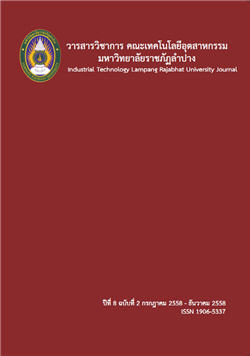8. การลดค่าความไม่แน่นอนจากการวัด เพื่อปรับปรุงประสิทธิภาพในการใช้โอห์มมิเตอร์
DOI:
https://doi.org/10.14456/itjlp.2015.18Keywords:
ความไม่แน่นอนจากการวัด, โอห์มมิเตอร์, ค่าความต้านทาน, การสอบเทียบ, Uncertainty measurement, Ohmmeter, Resistance, CalibrationAbstract
วิจัยครั้งนี้มีวัตถุประสงค์เพื่อวิเคราะห์ปัญหาและการหาแนวทางในการลดค่าความไม่แน่นอนจากการวัดเพื่อปรับปรุงประสิทธิภาพในการใช้โอห์มมิเตอร์ โดยการคัดเลือกโอห์มมิเตอร์ที่จะต้องดำเนินการปรับปรุงเพื่อลดค่าความไม่แน่นอนจากการวัด จากทั้งหมด 27 เครื่อง มีเครื่องที่ไม่พร้อมใช้งานทั้งหมด 9 เครื่อง นำทั้ง 9 เครื่อง มาทำการทดสอบการวัดตามกระบวนการที่น่าเชื่อถือได้ อ้างอิงจากสถาบันมาตรวิทยาแห่งชาติ เครื่องที่ผ่านกระบวนการวัด 7 เครื่อง และได้เครื่องที่ต้องลดค่าความไม่แน่นอนจากการวัด จำนวน 2 เครื่อง โดยอยู่ในเงื่อนไขค่าที่วัดได้มีค่ามากกว่าค่าจำกัดในด้านสูง
ผลการวิจัย พบว่าวิธีการลดค่าความต้านทานของหน้าสัมผัสระหว่างรอยต่อ (connectors) และสายวัด (cable) โดยการลดค่าความต้านทานของสายที่ใช้ในการวัด ที่มีตัวนำเป็นนิเกิล ความยาว 127.8 cm. จำนวน 2 เส้นนำมาขนานกันแต่ละข้างให้ค่าความต้านทานรวมลดลงเหลือ 0.025 W มีค่าความไม่แน่นอนจากการวัดที่ได้จากการคำนวณก่อนการปรับปรุงมีค่าเท่ากับ 0.12 โอห์ม และ 0.13 โอห์ม ที่ค่า k = 2 ที่ร้อยละ 95 และหลังการปรับปรุงสายวัด ค่าความไม่แน่นอนจากการวัด ที่ได้จากการสอบเทียบตามมาตรฐาน ISO 17025 เท่ากับ 0.06 โอห์ม แล 0.11 โอห์ม ที่ค่า k = 2 ที่ร้อยละ 95 ผลสรุปทำให้โอห์มมิเตอร์ สามารถนำกลับมาวัดค่าได้อย่างถูกต้องและอยู่ในช่วงที่สามารถใช้งานได้ปกติ
Reduction of the uncertainty measurements to the efficiency improvement of an Ohmmeter.
This research aimed to reduce the uncertainty of measurements and to increase the efficiency of an Ohmmeter. Data were collected from 27 instruments, which were tested for reliability. It was discovered that did not function properly, while 7 passed the National Institute of Metrology standards. 2 were needed to reduce uncertainties in measurement whenever the measured value was greater than the upper limit of the high-side measurement.
Uncertainties in measurement caused by connectors and cables require reducing the resistance of the wire cable used for the measurement. Two nickel conductors 127.8 cm long were connected in parallel in order to reduce resistance to 0.025 ohm. Two ohmmeters were then measured and tested according to the ISO17025 standards. The results show that the first two ohmmeters originally had an uncertainty measurement of 0.12 ohm and 0.13 ohm by a coverage factor of k = 2, giving a level of confidence of approximately 95%. After introducing the proposed uncertainty-reduction method, the uncertainties in measurement were calculated at 0.06 ohm and 0.11 ohm by a coverage factor of k = 2, giving a level of confidence of approximately 95%.






